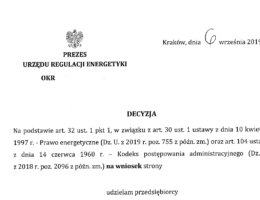At the outset, it should be noted that a license for the generation of electricity(WEE), in a renewable source installation, such as a photovoltaic (PV) installation or wind farm, is required if you intend to generate electricity in a RES installation , except for micro or small installations and installations that generate electricity from agricultural biogas, only from agricultural biogas in cogeneration, and only from bioliquids.
Which RES installations require a license?
According to the Law on Renewable Energy Sources, an installation of a renewable energy source with a total installed electrical power of not more than 50 kW, connected to an electric grid with a rated voltage of less than 110 kV or with a cogenerated thermal power of not more than 150 kW, with a total installed electrical power of not more than 50 kW, is considered a micro-installation. On the other hand, a renewable energy source installation with a total installed electrical capacity of more than 50 kW and less than 500 kW, connected to an electricity grid with a rated voltage lower than 110 kV or with a cogenerated thermal generating capacity of more than 150 kW and not more than 900 kW, in which the total installed electrical capacity is more than 50 kW and less than 500 kW, is considered a small installation.
Taking the above into account, the production of energy in a renewable energy source which constitutes a microinstallation or small installation requires, as a rule, obtaining a license for energy production (WEE) issued by the President of the Energy Regulatory Office (ERO).
The President of the Energy Regulatory Office and the Territorial Branches of the ERO responsible for issuing licenses
The body issuing licenses for the production of energy in a renewable energy source installation is the President of the Energy Regulatory Office and the appropriate Territorial Branches of the ERO in whose jurisdiction the installation producing energy from RES is to be located. On the ERO website, you can find a detailed list of the areas for which the respective ERO Territorial Branch is responsible.
Where to find and what are the prerequisites for obtaining a license to generate energy in a RES installation?
The conditions under which a license to generate electricity in a RES installation can be obtained are contained in the Energy Law and the Law on Freedom of Conduct of Business. In addition, the ERO President, in order to facilitate the preparation of an application for a license to generate electricity in a RES installation, has developed so-called Information Packages, which contain useful tips on the process of obtaining a license to generate electricity in a RES installation , information on the license proceedings conducted by the ERO President and the formal conditions to be met when applying for a license to generate electricity in a RES installation.
Applicants applying for a license for the production of electricity from RES installations will find in the Information Packages answers to the most frequent questions: what conditions must be met in order to obtain a license for the production of electricity from RES installations, and what documents and in what form should be attached to the application for a license for the production of electricity from RES.
In our opinion, the above-mentioned packages are very helpful for license applicants and facilitate the collection of all necessary documents for the preparation of an application for a license for the production of electricity in RES.
New requirements for the application for a license to produce energy from renewable energy sources
It is worth pointing out that due to the entry into force of Article 32(1a) of the Energy Law on January 1, 2020, there have been changes regarding the content of the application for a license to generate electricity from renewable energy sources.
Pursuant to the above-mentioned provision of the Energy Law, a license to carry out the activity of generating electricity from renewable energy sources, for the first time, shall be issued only if the equipment included in the RES installation used to generate energy:
1. meet the requirements set forth in Article 74(1) of the Renewable Energy Sources Law. That is, the equipment used to generate electricity, installed during construction or modernization, has been produced within a period of 42 months, and in the case of an installation using only solar energy to generate electricity – within a period of 24 months, onshore wind energy – within a period of 33 months, offshore wind energy – within a period of 72 months – immediately preceding the date of first generation of electricity in this renewable energy source installation. In addition, these facilities must not have been previously depreciated within the meaning of accounting regulations by any entity.
or
2. have a valid confirmation of conformity with the certified type of equipment or a declaration of conformity with the relevant standards issued by their manufacturer for the specific location of the renewable energy source installation, and have been manufactured no earlier than 72 months before the date on which electricity was first generated in the installation.
It is worth paying attention to these requirements already at the stage of designing a given RES installation and selecting component suppliers. It is worth pointing out that the ERO verifies this information both by requesting documents and possibly presenting generator nameplates.
What is the procedure for obtaining a license to generate electricity in a RES installation ?
The procedure itself for obtaining a license for the production of electricity in RES, is aimed at verifying that the applicant, has adequate financial and material resources, as well as knowledge and experience, necessary to carry out the activity of electricity production in a renewable energy source installation. In addition to the license application, the ERO may ask for additional documents and explanations.
Is a WEE license necessary to take advantage of the feed in tariff (FIT) and feed in premium (FIP) support sytems ?
What is also extremely important, only licensed energy companies, as well as companies entered in the mentioned registers of regulated activities (if a license or entry is required), generating electricity in a renewable energy source installation ( including photovoltaic installations and wind farms), can apply for certificates of origin referred to in Art. 45 of the Law on Renewable Energy Sources (provided that the first generation of electricity in the installation took place before July 1, 2016) or participate in the auction support system for electricity generation from renewable energy sources or tariff support systems, the so-called feed in tariff (FIT) and feed in premium (FIP).
How to prepare and what to pay attention to in the application for a WEE license?
The concession procedure is initiated after submitting an application for a license for the production of electricity in a photovoltaic installation, which should include information about the planned activity, including a business plan for conducting the activity of producing electricity in a RES installation and a description of the entrepreneur’s previous activity.
In our experience, in the case of newly established companies, one of the key issues to obtain a license is to have sufficient financial resources to operate under a license for the production of electricity in RES.
It should also be emphasized that the ERO President, when assessing the financial capacity of an entity applying for a license to generate electricity in a renewable energy source facility, takes into account the financial resources that the applicant may actually have at his disposal. This condition will not be fulfilled by, for example, non-binding commitments of third parties to invest, letters of intent or other non-binding declarations of recapitalization of an entity applying for a license to generate electricity from renewable energy sources.
It is also worth noting the form of documents attached to the application for a license for the production of electricity from RES. Some documents may be submitted only in the original, e.g., information on no criminal record from the National Criminal Register issued with respect to the entity applying for a license for the production of electricity in a RES installation, and separately the members of the board of directors and persons authorized to represent. If the applicant is a citizen of, or is based in, one of the member states of the European Union, the Swiss Confederation and the member states of the European Free Trade Agreement (EFTA), the information about the lack of criminal record should come from the register of the relevant country and be provided, together with a sworn translation and an apostille clause, which should also be translated by a sworn translator. In addition, the documents submitted must not be older than 3 months from the date of their submission to the ERO.
What may be obvious but not always observed by applicants is that each page of the application or attachment to the application for a license must be signed by persons authorized to represent.
How long does it take to obtain a license to generate energy in a RES installation (WEE) ?
In our experience, the process of obtaining a license to generate electricity in a RES installation takes from 2 to 3 months. It is worth pointing out that a well-prepared application for a WEE license will ensure the smooth conduct of the proceedings before the ERO and allow the RES installation to be fully operational without delay. In case of deficiencies in the application, the ERO may direct requests to supplement the deficiencies or submit additional documents to the license application.
How much are the fees for issuing a license for the production of energy in a RES installation (WEE) ?
According to Article 8 (1) of the Stamp Duty Law, the stamp duty rates for activities related to the scope of the ERO President, are:
- for issuance of a promise (a promise of a concession or a promise to change the concession) – PLN 98 (Part I item 20 of the Appendix to the Act on Stamp Duty);for prolongation of validity or change in conditions of a promise of a concession (a promise of a concession or a promise to change the concession) – PLN 44 (Part I item 21 of the Appendix to the Act on Stamp Duty)
- for extending the validity date or changing the conditions of a promise of a permit (a promise of a concession or a promise to change a concession) – PLN 44 (Part I, item 21 of the Appendix to the Act on Stamp Duty);
- for the issuance of a permit (WEE concession ) – PLN 616 (Part III, item 44 of the Annex to the Stamp Duty Act).
What are the sanctions for energy production without a WEE license?
It is worth noting that carrying out business activities without the required license, according to Article 601 of the Law of May 20, 1971. – Code of Offenses. is punishable by restriction of freedom or a fine.
Summary
In conclusion, it should be pointed out that a well-prepared application for a WEE license will ensure the smooth conduct of the proceedings before the ERO and will allow you to fully launch your RES installation without delay.
Our lawyers remain at your disposal, either to conduct the entire concession proceedings before the ERO President or to prepare only specific parts of the concession application, in particular the so-called business plan of the licensed activity.



